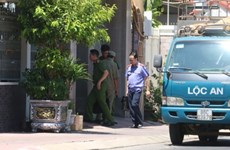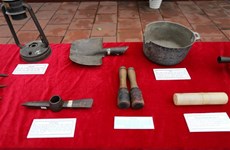Lessons learned during fight against COVID-19 pandemic
Vietnam has learned many lessons during the unprecedented fight against COVID-19.
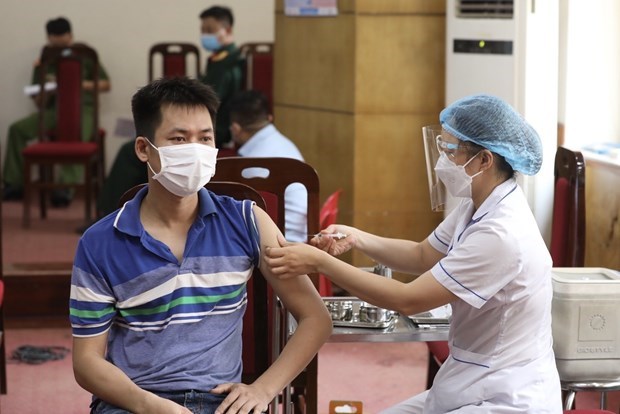 The COVID-19 vaccination campaign in Hanoi is being carried out at healthcare centres in districts and towns (Photo: VNA)
The COVID-19 vaccination campaign in Hanoi is being carried out at healthcare centres in districts and towns (Photo: VNA)The resurgence of the pandmeic has hit key economic areas in both northern and southern regions.
The pandemic marked a new milestone on July 26 as the number of infection cases surpassed the 100,000 benchmark.
Over 50,000 new cases recorded in eight days
Experts said the Delta and Delta Plus strains are spreading much faster than previous variants and are become extremely dangerous, wreaking havoc on many countries around the world, including Vietnam.
The COVID-19 pandemic began in Vietnam on January 23, 2020. During the first three outbreaks, which lasted for about one and a half years, the country managed to keep transmission rates relatively low, with fewer than 3,000 cases.
However, the fourth wave of infections since April 27 has been unpredictable in its development.
The tally of infected surpassed 10,000 on June 12, one and a half years after the pandemic first broke out.
Less than one month later, it exceeded 20,000 to stand at 20,261 on July 5. The country recorded another 10,000 cases on July 12 and over 20,000 between July 12 and 18, raising the national count to 50,000. The figure has been increasing by nearly 10,000 each day, since July 18.
The total number of infections totalled 100,000 on July 26, doubling in just eight days.
As of the morning of July 27, there have been 109,111 cases in total, including 2,203 imported cases and 106,908 domestic infections. That includes 105,338 cases in the fourth wave of COVID-19, with 18,570 recoveries. Meanwhile, 524 patients have unfortunately succumbed to the disease.
 Medical workers tend a COVID-19 patient at an intensive care unit in the southern province of Binh Duong (Photo: VietnamPlus)
Medical workers tend a COVID-19 patient at an intensive care unit in the southern province of Binh Duong (Photo: VietnamPlus)Ho Chi Minh City posted the biggest number of infections, with over 68,000, followed by nearby Binh Duong (over 8,800), Dong Nai (over 2,500), Dong Thap (over 2,200), Tien Giang (over 1,800), and Phu Yen (over 1,000).
Hanoi has also reported more than 800 cases during this latest outbreak, including nearly 500 infections in the community.
Entire political system struggles with pandemic
Facing the complex situation, the entire political system has been exerting every effort to combat the pandemic.
The Government, along with multiple ministries, sectors and localities have undertaken a number of solutions, specifically the imposition of strict social distancing under the Prime Minister’s Directive 16/CT-TTg in 19 southern provinces and cities. Hanoi has also been applying this directive since July 24.
The Ministry of Health has mobilised nearly 7,000 personnel, from central and local units, to assist the fight against the pandemic in HCM City and other southern localities, which are also applying their own measures to contain the transmission.
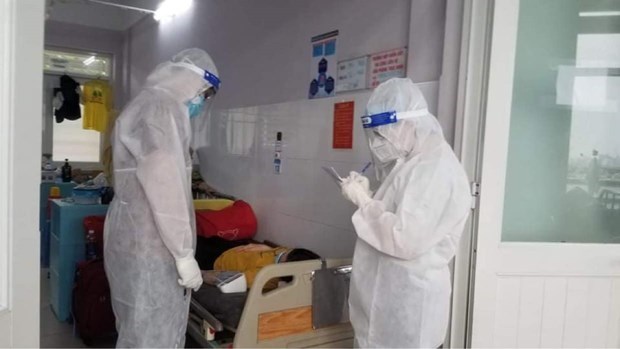 Health workers tend a COVID-19 patient in Thu Duc city of HCM City (Photo: VietnamPlus)
Health workers tend a COVID-19 patient in Thu Duc city of HCM City (Photo: VietnamPlus)Striving to minimise new infections and deaths
Minister of Health Nguyen Thanh Long said most sources of virus transmission have been identified thanks to contact tracing, adding that the surge in new cases is due to the acceleration of sample collection and testing in high-risk quarantine and locked-down areas.
However, he noted, anti-pandemic measures under Directive 16 in some localities and by some agencies have yet to be carried out rigorously. People are still not taking the threat of COVID-19 seriously enough in certain places, Long said.
Contact tracing, testing, quarantine, monitoring, treatment and logistics have been improved but these measures are still unable to keep pace with the spread of the coronavirus, Long added.
Assoc. Prof. Tran Dac Phu, adviser to Vietnam’s public health emergency operations centre, said it is necessary to maintain the strategy directed by the PM to cope with the new variants. The core of which is minimising the number of new infections, since it will be very difficult to keep the fatality count low if these are not reduced.
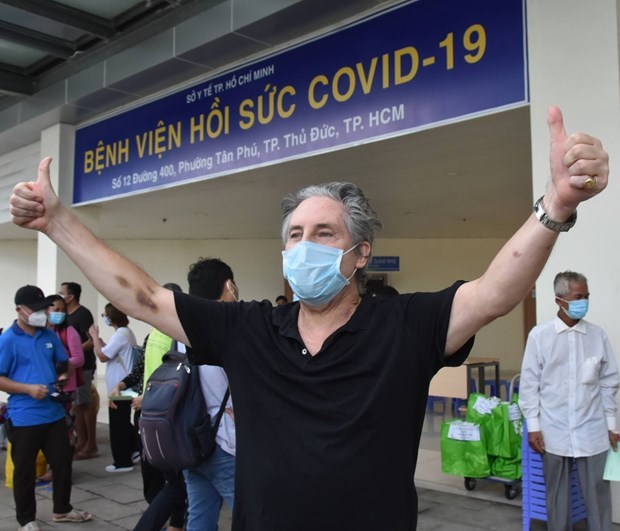 A patient displays a celebratory gesture as he is discharged from the COVID-19 Resuscitation Hospital in Thu Duc in HCM City (Photo: VietnamPlus)
A patient displays a celebratory gesture as he is discharged from the COVID-19 Resuscitation Hospital in Thu Duc in HCM City (Photo: VietnamPlus)Phu stated that the resolution will assist all localities, ministries and sectors to stay proactive in purchasing medicines, supplies and equipment necessary in the endeavour.
The Health Ministry has urged localities to continue mobilising forces to prevent transmission of the virus, reduce new infections and fatalities and protect safe zones. Aside from prioritising the fight against COVID-19, they also need to guarantee social security, the smooth flow of essential goods and support for affected people.
Drastic moves to implement vaccine strategy
Experts believe that the fastest way to eliminate the pandemic is stepping up the vaccination rollout, which is also the long-term solution.
Minister Long said, as directed by the Politburo and the Party Central Committee’s Secretariat, since the beginning of 2020, the Government has pushed ahead with a vaccine strategy that covers vaccine procurement, technology transfer, production and administration.
 The US Government has provided more than 5 million doses of Moderna COVID-19 vaccine to Vietnam via the COVAX Facility (Photo: VietnamPlus)
The US Government has provided more than 5 million doses of Moderna COVID-19 vaccine to Vietnam via the COVAX Facility (Photo: VietnamPlus)‘Vaccine diplomacy’ has been strongly promoted in negotiation efforts at bilateral and multilateral meetings by Party and State leaders.
So far, Vietnam has secured commitments to get more than 130 million vaccine doses through agreements with China, the US, Japan, Australia, the UK, and other countries. It is working hard to see another 40 million doses enter the country to total 170 million doses by the end of 2021.
Regarding vaccine development and production technology transfer, Vietnam is one of the first four countries to succeed in culturing and isolating the novel coronavirus, paving the way for vaccine development. This began in the first quarter of 2020. It is also the first Southeast Asian country to conduct third-phase human trials of a COVID-19 vaccine.
PM Pham Minh Chinh also demanded special attention and priority be given to the domestic production of a COVID-19 vaccine as soon as possible.
As of July 27, 4,746,642 vaccine doses were administered, including 4,323,571 first shots and 423,071 second shots./.









